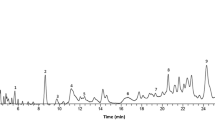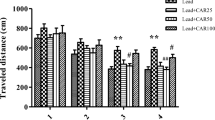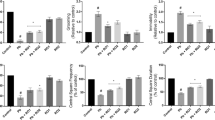Abstract
Neuroimmune alterations have important implication in the neuropsychiatric symptoms and biochemical changes associated with lead-induced neurotoxicity. It has been suggested that inhibition of neuroinflammatory-mediated lead-induced neurotoxicity by phytochemicals enriched with antioxidant activities would attenuate the deleterious effects caused by lead. Hence, this study investigated the neuroinflammatory mechanism behind the effect of Ginkgo biloba supplement (GB-S) in lead-induced neurotoxicity in mice brains. Mice were intraperitoneally pretreated with lead acetate (100 mg/kg) for 30 min prior the administration of GB-S (10 and 20 mg/kg, i.p.) and ethylenediaminetetraacetic acid (EDTA) (50 mg/kg, i.p.) for 14 consecutive days. Symptoms of neurobehavioral impairment were evaluated using open field test (OFT), elevated plus maze (EPM), and tail suspension test (TST) respectively. Thereafter, mice brain hippocampi were sectioned for myeloperoxidase activity (MPO), pro-inflammatory cytokine (TNF-α and IL-6) estimation and inflammatory protein (NF-κB) expression. Furthermore, histomorphormetric studies (Golgi impregnation and Cresyl violet stainings) were carried out. GB-S (10 and 20 mg/kg) significantly restores neurobehavioral impairments based on improved locomotion, reduced anxiety- and depressive-like behavior. Moreover, GB-S reduced the MPO activity, inhibits TNF-α, IL-6 release, and downregulates NF-κB immunopositive cell expression in mice hippocampus. Histomorphometrically, GB-S also prevents the loss of pyramidal neuron in the hippocampus. The endpoint of this findings suggest that GB-S decreases neuropsychiatric symptoms induced by lead acetate through mechanisms related to inhibition of release of pro-inflammatory mediators and suppression of hippocampal pyramidal neuron degeneration in mice.













Similar content being viewed by others
References
Fenn AM, Henry CJ, Huang Y, Dugan A, Godbout JP (2012) Lipopolysaccharide-induced interleukin (IL)-4 receptor-alpha expression and corresponding sensitivity to the M2 promoting effects of IL-4 are impaired in microglia of aged mice. Brain Behav Immun 26:766–777
Elmore MR, Najafi AR, Koike MA et al (2014) Colonystimulating factor 1 receptor signaling is necessary for microglia viability, unmasking a microglia progenitor cell in the adult brain. Neuron 82:380–397
Ben-Azu B, Aderibigbe AO, Ajayi AM, Eneni AO, Umukoro S, Iwalewa EO (2019) Involvement of GABAergic, BDNF and Nox-2 mechanisms in the prevention and reversal of ketamine-induced schizophrenia-like behavior by morin in mice. Brain Res Bull 139:292–306
Wopara I, Modo EU, Adebayo OG, Mobisson SK, Nwigwe JO, Ogbu PI, Nwankwo VU, Ejeawa CU (2021) Anxiogenic and memory impairment effect of food color exposure: upregulation of oxido-neuroinflammatory markers and acetyl-cholinestrase activity in the prefrontal cortex and hippocampus. Heliyon 7(3):e06378. https://doi.org/10.1016/j.heliyon.2021.e06378
Umukoro S, Ben-Azu B, Ajayi AM, Adebesin A, Emokpae O (2020) Cymbopogon citratus aqueous leaf extract attenuates neurobehavioral and biochemical changes induced by social defeat stress in mice. Chin Herb Med 12(3):303–309
Cermenati G, Mitro N, Audano M, Melcangi RC, Crestani M, De Fabiani E (1851) Caruso D (2015) Lipids in the nervous system: from biochemistry and molecular biology to patho-physiology. Biochim Biophys Acta 1:51–60
Schmitt F, Hussain G, Dupuis L, Loeffler JP, Henriques A (2014) A plural role for lipids in motor neuron diseases: energy, signalling and structure. Front Cell Neurosci 8:25
Müller CP, Reichel M, Mühle C, Rhein C, Gulbins E (1851) Kornhuber J (2015) Brain membrane lipids in major depression and anxiety disorders. Biochim Biophys Acta 8:1052–1065
Singh PK, Rawat A, Dixit RK, Kumar P, Nath R (2017) Behavioral and neurochemical effects of omega-3 fatty acids against lead acetate exposure in male Wistar rats: an experimental study. Int J Curr Res 7:20936–20944
Adebayo OG, Wopara I, Ben-Azu B, Aduema W, Adebayo OR, Nicodemus OU (2020) Acute Lead (II) Acetate 3-hydrate neurotoxicity alters neurocognition and induced depressive-like behavior via 5-hydroxytryphtamine, neurohormone melatonin and (Na+, K+)-ATPase activity in female Wistar rats. Asian J Biotechnol Genet Eng 20:31–40
Atuadu V, Benneth BA, Oyem J, Esom E, Mba C, Nebo K, Ezemeka G, Anibeze C (2020) Adansonia digitata L. leaf extract attenuates lead-induced cortical histoarchitectural changes and oxidative stress in the prefrontal cortex of adult male Wistar rats. Drug Metab Pers Ther. https://doi.org/10.1515/dmdi-2020-0116
Zare MF, Niknazar S, Yadegari M, Akbari FA, Pirmoradi Z, Khaksari M (2020) Carvacrol reduces hippocampal cell death and improves learning and memory deficits following lead-induced neurotoxicity via antioxidant activity. Naunyn Schmiedebergs Arch Pharmacol 393(7):1229–1237. https://doi.org/10.1007/s00210-020-01866-6
Baranowska-bosiacka I, Strużyńska L, Gutowska I, Machalińska A, Kolasa A, Kłos P, Czapski G, Kurzawski M, Prokopowicz A, Marchlewicz M (2013) Perinatal exposure to lead induces morphological, ultrastructural andmolecular alterations in the hippocampus. Toxicology 303:187–200
Verma S, Sharma S, Ranawat P, Nehru B (2020) Modulatory effects of Ginkgo biloba against amyloid aggregation through induction of heat shock proteins in aluminium induced neurotoxicity. Neurochem Res 45:465
Chen M, Zou W, Chen M, Cao L, Ding J, Xiao W, Hu G (2018) Ginkgolide K promotes angiogenesis in a middle cerebral artery occlusion mouse model via activating JAK2/STAT3 pathway. Eur J Pharmacol 833:221–229
Yang X, Zheng T, Hong H, Cai N, Zhou X, Sun C, Wu L, Liu S, Zhao Y, Zhu L, Fan M, Zhou X, Jin F (2018) Neuroprotective effects of Ginkgo biloba extract and ginkgolide B against oxygen-glucose deprivation/reoxygenation and glucose injury in a new in vitro multicellular network model. Front Med 12:307–318
Singh B, Kaur P, Gopichand C, Singh BD, Ahuja PS (2008) Biology and chemistry of Ginkgo biloba. Fitoterapia 79:401–418
Liao HJ, Zheng YF, Li HY, Peng GP (2011) Two new ginkogolides from leaves of Ginkgo biloba. Planta Med 77:1818–1821
Ude C, Schubert-Zsilavecz M, Wurglics M (2013) Ginkgo biloba extracts: a review of the pharmacokinetics of the active ingredients. Clin Pharmacokinet 52(9):727–749
Osman NM, Amer AS, Abdelwahab S (2016) Effects of Ginko biloba leaf extract on the neurogenesis of the hippocampal dentate gyrus in the elderly mice. Anat Sci Int 91:280–289
Sadeghinejada M, Soltanib Z, Afzalpoura ME, Khaksaric M, Pourranjbard M (2019) What is the combined effect of intense intermittent exercise and Ginkgo biloba plant on the brain neurotrophic factors levels, and learning and memory in young rats? Pharmacol Rep 71:503–508
Yao J, Qiao H, Jin Z, Wang R, Huang H, Fang L, Chen Y, Tai K, Doeppner TR, Chen Z, Kuchta K (2020) Ginkgo biloba and its constituent 6-hydroxykynurenic-acid as well as its proanthocyanidins exert neurorestorative effects against cerebral ischemia. Planta Med 86(10):696–707
Yapar K, Cavusoglu K, Oruc E, Yalcin E (2010) Protective role of Ginkgo biloba against hepatotoxicity and nephrotoxicity in uranium-treated mice. J Med Food 13(1):179–188
Kaur S, Chhabra R, Nehru B (2013) Ginkgo biloba extract attenuates hippocampal neuronal loss and cognitive dysfunction resulting from trimethyltin in mice. Phytomed 20(2):178–186
Abd-Elhady RM, Elsheikh AM, Khalifa AE (2013) Ani-amnesic properties of Ginkgo biloba extract on impaired memory function induced by aluminum in rats. Int J Dev Neurosci 31(7):598–607
Yallapragada RP, Velaga MK (2015) Effect of Ginkgo biloba extract on lead-induced oxidative stress in different regions of rat brain. J Environ Pathol Toxicol Oncol 34(2):161–173
National Institute of Health Guide for the Care and Use of Laboratory Animals (1996) Washington DC: National Academic Press
Oshio LT, Ribeiro CCT, Marques RM, Guerra MO, Pinto da Matta SL, de Paula Reis JE, Sá RCS, Campos LV, Peters VM (2015) Effect of Ginkgo biloba extract on sperm quality, serum testosterone concentration and histometric analysis of testes from adult Wistar rats. J Med Plants Res 9(5):122–131. https://doi.org/10.5897/JMPR2015.5730
Ekici Gunay N, Muhtaroglu S, Bedirli A (2018) Administration of Ginkgo biloba extract (EGb761) alone and in combination with FK506 promotes liver regeneration in a rat model of partial hepatectomy. Balkan Med J 35(2):174–180
Nishimon S, Yamaguchi M, Muraki H, Sakai N, Nishino S (2020) Intraperitoneal injection of ginkgolide B, a major active compound of Ginkgo biloba, dose-dependently increases the amount of wake and decreases non-rapid eye movement sleep in C57BL/6 mice. Neurosci Lett 722:134832
Walsh RN, Cummins RA (1976) The open-field test: a critical review. Psychol Bull 83:482–504
Izídio GS, Lopes DM, Spricigo L Jr, Ramos A (2005) Common variations in the pretest environment influence genotypic comparisons in models of anxiety. Genes Brain Behav 4(7):412–419. https://doi.org/10.1111/j.1601-183X.2005.00121.x
Dereli FTG, Ilhan M, Akkol EK (2018) Discovery of new antidepressant agents: in vivo study on Anthemis wiedemanniana Fisch. & Mey. J Ethnopharmacol 226:11–16
Handley SL, Mithani S (1984) Effects of a-adrenoreceptor agonists and antagonists in a maze-exploration model of ‘fear’-motivated behavior. Naunyn-Schmeide-berg′s Arch Pharmacol 327(1):1–5
Pellow S, Chopin P, File SE, Briley M (1985) Validation of open: closed arm entries in an elevated plus-maze as a measure of anxiety in the rat. J Neurosci Methods 14(3):149–167
Gornall AG, Bardawill CJ, David MM (1949) Determination of serum proteins by means of the biuret reaction. J Biol Chem 177(2):751–766
Bradley PP, Priebat DA, Christensen RD, Rothstein G (1982) Measurement of cutaneous inflammation: estimation of neutrophil content with an enzyme marker. J Invest Dermatol 78:206–209
Angulo E, Fernandez JA, Merchan M, Molina (1996) A reliable method for Golgi staining of retina and brain slices. J Neurosci Methods 66:55–59
Edelstein AD, Mark AT, Nenad A, Henry P, Ronald DV, Nico S (2014) Advanced methods of microscope control using μManager software. J Biol Methods 1:e10
Wu A, Liu Y (2000) Apoptotic cell death in rat brain following deltamethrin treatment. Neurosci Lett 279:85–88
Peng C, Trojanowski JQ, Lee VM (2020) Protein transmission in neurodegenerative disease. Nat Rev Neurol 16(4):199–212
Feng YK, Wu QL, Peng YW, Liang FY, You HJ, Feng YW, Li G, Li XJ, Liu SH, Li YC, Zhang Y (2020) Oral P. gingivalis impairs gut permeability and mediates immune responses associated with neurodegeneration in LRRK2 R1441G mice. J Neuroinflammation 17(1):1–2
Dardiotis E, Rikos D, Siokas V, Aloizou AM, Tsouris Z, Sakalakis E, Brotis AG, Bogdanos DP, Hadjigeorgiou GM (2020) Assessment of TREM2 rs75932628 variant’s association with Parkinson’s disease in a Greek population and meta-analysis of current data. Int J Neurosci 20:1–5
Peng X, Li C, Yu W, Liu S, Cong Y, Fan G, Qi S (2020) Propofol attenuates hypoxia-induced inflammation in BV2 microglia by inhibiting oxidative stress and NF-κB/Hif-1α signaling. Biomed Res Int 2020:8978704
Srejovic I, Selakovic D, Jovicic N, Jakovljević V, Lukic ML, Rosic G (2020) Galectin-3: roles in neurodevelopment, neuroinflammation, and behavior. Biomolecules 10(5):798
Azogu-Sepe I, Plamondon H (2021) Stress responsiveness of BDNF/TrkB signaling in the neuroendocrine system and future implications. In: Stress: Genetics, Epigenetics and Genomics 145–158
Gold PW (2015) The organization of the stress system and its dysregulation in depressive illness. Mol Psychiatry 20:32–47
Welcome MO (2020) Cellular mechanisms and molecular signaling pathways in stress-induced anxiety, depression, and blood–brain barrier inflammation and leakage. Inflammopharmacology 28(3):643–665
McEwen BS, Gray JD, Nasca C (2015) Recognizing resilience: learning from the effects of stress on the brain. Neurobiol Stress 1:1–11
Kumari P, Wadhwa M, Chauhan G, Alam S, Roy K, Jha PK, Kishore K, Ray K, Nag TC, Panjwani U (2020) Hypobaric hypoxia induced fear and extinction memory impairment and effect of Ginkgo biloba in its amelioration: behavioral, neurochemical and molecular correlates. Behav Brain Res 387:112595
Davies MJ, Hawkins CL (2020) The role of myeloperoxidase in biomolecule modification, chronic inflammation, and disease. Antioxid Redox Signal 32(13):957–981
Chen S, Chen H, Du Q, Shen J (2020) Targeting myeloperoxidase (MPO) mediated oxidative stress and inflammation for reducing brain ischemia injury: potential application of natural compounds. Front Physiol 11:433
Volkman R, Ben-Zur T, Kahana A, Garty BZ, Offen D (2019) Myeloperoxidase deficiency inhibits cognitive decline in the 5XFAD mouse model of Alzheimer’s disease. Front Neurosci 13:990. https://doi.org/10.3389/fnins.2019.00990
Tannich F, Tlili A, Pintard C, Chniguir A, Eto B, Dang PM, Souilem O, El-Benna J (2020) Activation of the phagocyte NADPH oxidase/NOX2 and myeloperoxidase in the mouse brain during pilocarpine-induced temporal lobe epilepsy and inhibition by ketamine. Inflammopharmacology 28(2):487–497. https://doi.org/10.1007/s10787-019-00655-9
Üllen A, Singewald E, Konya V, Fauler G, Reicher H, Nusshold C et al (2013) Myeloperoxidase-derived oxidants induce blood-brain barrier dysfunction in vitro and in vivo. PLoS One 8:e64034. https://doi.org/10.1371/journal.pone.0064034
Leonard B, Maes M (2012) Mechanistic explanations how cell-mediated immune activation, inflammation and oxidative and nitrosative stress pathways and their sequels and concomitants play a role in the pathophysiology of unipolar depression. Neurosci Biobehav Rev 36:764–785
Vavakova M, Durackova Z, Trebatick J (2015) Markers of oxidative stress and neuroprogression in depression disorder. Oxid Med Cell Longev 12:898393. https://doi.org/10.1155/2015/898393
Olugbemide AS, Ben-Azu B, Bakre AG, Ajayi AM, Femi-Akinlosotu O, Umukoro S (2021) Naringenin improves depressive- and anxiety-like behaviors in mice exposed to repeated hypoxic stress through modulation of oxido-inflammatory mediators and NF-κB/BDNF expressions. Brain Res Bull 169:214–227
Li Z, Li J, Zhao W, Li Y (2020) Potential antiosteoporotic effect of Ginkgo biloba extract via regulation of SIRT1-NF-κB signaling pathway. J King Saud Univ-Sci 32(4):2513–2519
Rafaiee R, Khastar H, Garmabi B, Taleb M, Norouzi P, Khaksari M (2021) Hydrogen sulfide protects hippocampal CA1 neurons against lead mediated neuronal damage via reduction oxidative stress in male rats. J Chem Neuroanat 112:101917
Acknowledgements
Authors appreciate the technical assistant rendered during this study by Mr. Savior Inegbenehi and Mr. Martin U. Ukiwa of the Department of Biochemistry and Pharmacology, PAMO University Medical Sciences, Port Harcourt.
Author information
Authors and Affiliations
Contributions
Olusegun G. Adebayo—designed, managed the laboratory experiment and wrote the first draft of the manuscript. Benneth Ben-Azu—contributed in the design of the experiment, managed the laboratory experiment and participated in the writing of the manuscript. Abayomi M. Ajayi—managed the statistical analysis and participated in the writing of the manuscript. Iheanyichukwu Wopara—managed the laboratory experiment and statistical analysis. Wadioni Aduema—managed the laboratory experiment and statistical analysis. Tolunigba A. Kolawole—provided the materials for the study and managed the laboratory experiment. Elizabeth B. Umoren—managed the laboratory experiment and methodology. Ijeoma Onyeleonu—managed the laboratory experiment and methodology. Oloruntoba T. Ebo—provided the materials for the study and managed the literature searches. Doris N. Ajibo—Provided the materials for the study and managed the literature searches. Ajirioghene E. Akpotu—managed the literature searches and methodology. All authors read and approved the submission of the manuscript.
The institution, PAMO University of Medical Sciences Animal Research Ethics Committee (PUMS-AREC) which agreed with the “Guide to the care and use of laboratory animals in research and teaching” as prescribed in NIH publications volume 25 No.28 revised in 1996 approved the use of animal for this study
Corresponding authors
Ethics declarations
Conflict of interest
The authors declare that they have no conflict of interest.
Additional information
Publisher's Note
Springer Nature remains neutral with regard to jurisdictional claims in published maps and institutional affiliations.
Rights and permissions
About this article
Cite this article
Adebayo, O.G., Ben-Azu, B., Ajayi, A.M. et al. Gingko biloba abrogate lead-induced neurodegeneration in mice hippocampus: involvement of NF-κB expression, myeloperoxidase activity and pro-inflammatory mediators. Biol Trace Elem Res 200, 1736–1749 (2022). https://doi.org/10.1007/s12011-021-02790-3
Received:
Accepted:
Published:
Issue Date:
DOI: https://doi.org/10.1007/s12011-021-02790-3




